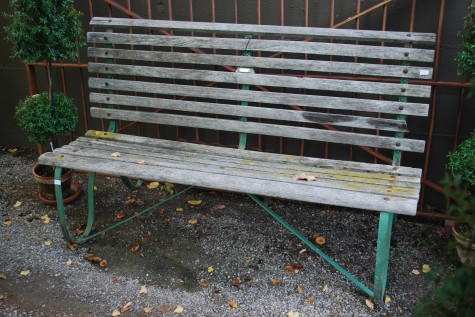 I could easily picture Gertrude Jekyll perched on this old English wood garden bench. Wearing a long skirt, a cardigan, and serviceable brogans, I can hear her in dignified fashion holding forth on some garden design topic or another with as much energy as authority. This straight-backed bench, of slight design and simple materials, is unmistakably English in origin. I have never been to Britain, and I know few people of British extraction-but I have looked at vintage and antique English garden furniture long enough to successfuly guess its origin.
I could easily picture Gertrude Jekyll perched on this old English wood garden bench. Wearing a long skirt, a cardigan, and serviceable brogans, I can hear her in dignified fashion holding forth on some garden design topic or another with as much energy as authority. This straight-backed bench, of slight design and simple materials, is unmistakably English in origin. I have never been to Britain, and I know few people of British extraction-but I have looked at vintage and antique English garden furniture long enough to successfuly guess its origin.
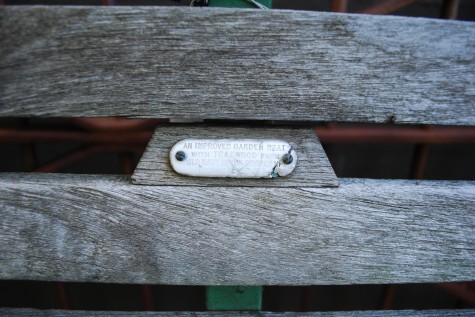
The old porcelain tag on this bench reveals the teak came from decommissioned and broken ships of the Royal Navy. How like the British to recycle disaster and the materials thereof without fanfare. What people designed and made for their gardens was so much a product of who they were, and the culture from whence they came. I have a much tougher time visually determining the origin of new garden ornament. Designers are able to access design and materials from all over the world now. I find some contemporary teak furniture cold and lacking flavor and identity, for this reason.
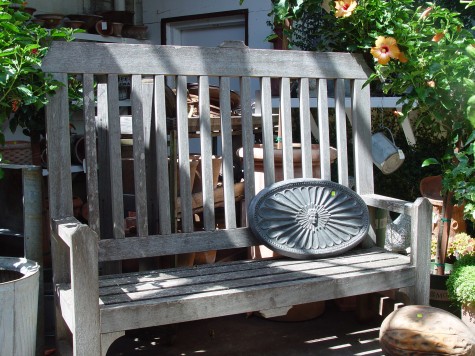 This decidedly English style high backed bench of utterly simple design is a contemporary piece that seems authentic to the culture of its origin. It used to be there were no designers, just craftspeople with good sense about proportion, practicality, and sturdy construction. What worked was also beautiful. This bench doesn’t try too hard. No doubt it will be in service a very long time, given its heft. Its visual heft makes it a good candidate for a special spot in a garden. It could just as easily hold a number of people waiting for a bus, or a pile of kids intent on climbing it.
This decidedly English style high backed bench of utterly simple design is a contemporary piece that seems authentic to the culture of its origin. It used to be there were no designers, just craftspeople with good sense about proportion, practicality, and sturdy construction. What worked was also beautiful. This bench doesn’t try too hard. No doubt it will be in service a very long time, given its heft. Its visual heft makes it a good candidate for a special spot in a garden. It could just as easily hold a number of people waiting for a bus, or a pile of kids intent on climbing it.
 Sir Edwin Lutyens was a British architect of great renown whose practice spanned the late 19th century and early 2oth century. Gardeners all over the world know of him, from his association with Gertrude Jekyll. Her steadfast support of his career, and the projects upon which they collaborated are well documented. The most beautiful bench of his design might be the Hestercombe bench, but the bench most often associated with his name is known as the Lutyens bench. The distinctively curved back and scrolled arms have been the inspiration for subsequent English bench-makers; this version is a beauty.
Sir Edwin Lutyens was a British architect of great renown whose practice spanned the late 19th century and early 2oth century. Gardeners all over the world know of him, from his association with Gertrude Jekyll. Her steadfast support of his career, and the projects upon which they collaborated are well documented. The most beautiful bench of his design might be the Hestercombe bench, but the bench most often associated with his name is known as the Lutyens bench. The distinctively curved back and scrolled arms have been the inspiration for subsequent English bench-makers; this version is a beauty.
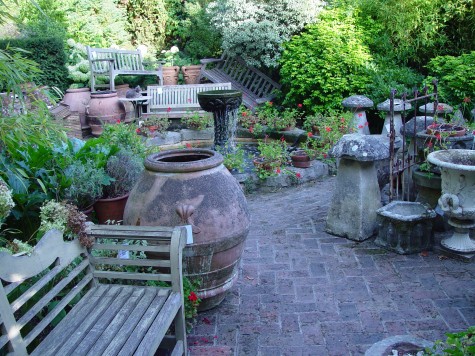 Many of our antique and vintage pieces come from dealers in England. Most of them represent garden objects from of other countries, not just their own. As much as the English gardener of my imagination is keenly interested in plants of all sizes, species and habit, the antique dealers we buy from with are game for anything that might endow a garden with beauty and history.
Many of our antique and vintage pieces come from dealers in England. Most of them represent garden objects from of other countries, not just their own. As much as the English gardener of my imagination is keenly interested in plants of all sizes, species and habit, the antique dealers we buy from with are game for anything that might endow a garden with beauty and history.
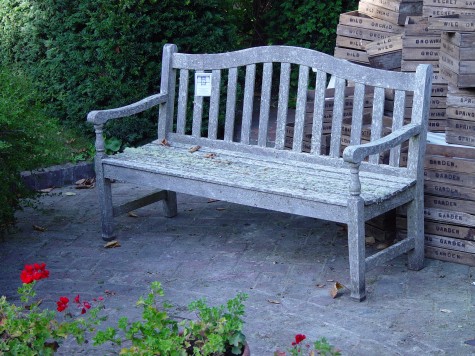 However, one must go to England to find English garden benches. Their modest and sturdy look is so appealing. Even the old benches clearly have many years of service yet to come. A colony of pale green lichens found a home on this bench-no doubt the result of many years of service in some English garden blessed with regular rain.
However, one must go to England to find English garden benches. Their modest and sturdy look is so appealing. Even the old benches clearly have many years of service yet to come. A colony of pale green lichens found a home on this bench-no doubt the result of many years of service in some English garden blessed with regular rain.
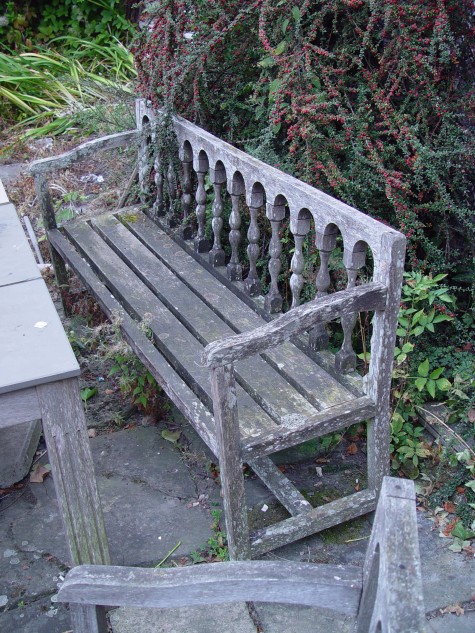 This quietly elegant spindle back bench is likewise mottled with colonies of this lichen and that moss. Its timeworn surface and low key design made it so easy to incorporate into a garden. British wood benches are team players.
This quietly elegant spindle back bench is likewise mottled with colonies of this lichen and that moss. Its timeworn surface and low key design made it so easy to incorporate into a garden. British wood benches are team players.
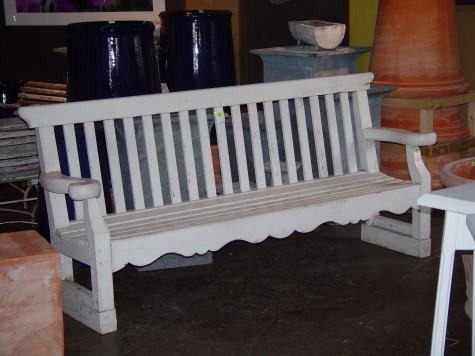 This old painted bench had sustained some dry rot from years of contact with the ground. We stabilized the legs from underneath, and placed it on a gravel terrace. Though 70 years old, I think my clients will enjoy it a good many more years. Painted furniture in a garden has a charm all its own. The frilly skirt and the angled back of this bench is a departure in form from most English benches I have known and loved-but how I like it.
This old painted bench had sustained some dry rot from years of contact with the ground. We stabilized the legs from underneath, and placed it on a gravel terrace. Though 70 years old, I think my clients will enjoy it a good many more years. Painted furniture in a garden has a charm all its own. The frilly skirt and the angled back of this bench is a departure in form from most English benches I have known and loved-but how I like it.
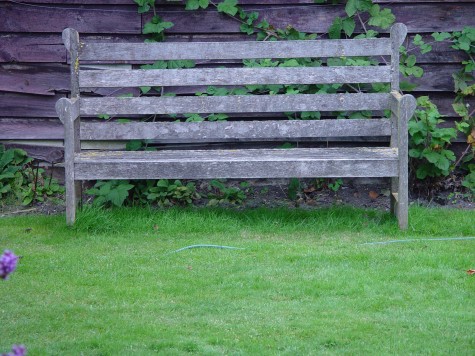
An old bench such as this one could quietly transform the garden into which it were placed. As Mary Keen says, “Nostalgia in gardening often surfaces as a longing for that older, deeper relationship between person and place that we rarely achieve in modern life.”
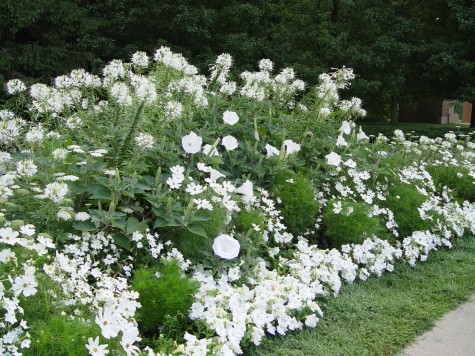
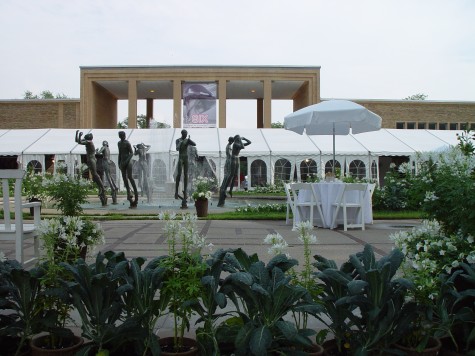 A large tent would be a temporary home to a collection of art destined for auction that evening. Each work was donated by a previous graduate of the academy; this part of the event generated considerable interest and participation. Tables reserved for groups representing the major benefactors for this event were placed in the fountain garden.
A large tent would be a temporary home to a collection of art destined for auction that evening. Each work was donated by a previous graduate of the academy; this part of the event generated considerable interest and participation. Tables reserved for groups representing the major benefactors for this event were placed in the fountain garden.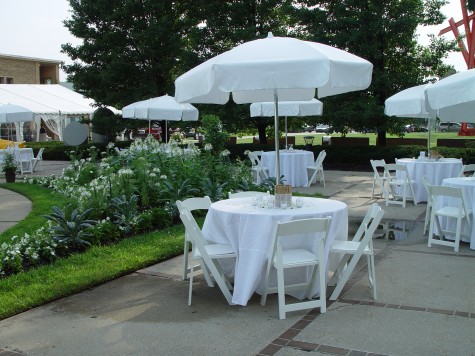 The remnants of puddles you see on the ground in the above picture bring back memories for me; it rained fiercely the afternoon of the event. What I had thought I would have the entire day to accomplish would have to be done in less time. The threat of bad weather makes any garden party all the more exciting to plan and produce-in this case, it was more excitement than I really wanted.
The remnants of puddles you see on the ground in the above picture bring back memories for me; it rained fiercely the afternoon of the event. What I had thought I would have the entire day to accomplish would have to be done in less time. The threat of bad weather makes any garden party all the more exciting to plan and produce-in this case, it was more excitement than I really wanted. 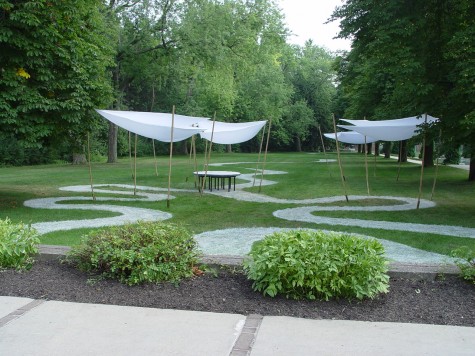 A cocktail reception would be held in a grassy area immediately adjacent to the showpiece of the Cranbrook landscape-the Triton pools. We fashioned simple tents for the hordoerves tables from double layers of white fabric attached to bamboo poles. Steel shoes for the poles were sunk in the ground at an outward angle, stretching the fabric tight and smooth. Nature had another idea in store; the intense downpour changed that flat profile to a graceful swoop. This unexpected contribution from the sky was a good one; I liked the swooping fabric against the curving path. We had painted a rambling path for guests arriving at the Lone Pine entrance to the garden to the reception area, with athletic paint.
A cocktail reception would be held in a grassy area immediately adjacent to the showpiece of the Cranbrook landscape-the Triton pools. We fashioned simple tents for the hordoerves tables from double layers of white fabric attached to bamboo poles. Steel shoes for the poles were sunk in the ground at an outward angle, stretching the fabric tight and smooth. Nature had another idea in store; the intense downpour changed that flat profile to a graceful swoop. This unexpected contribution from the sky was a good one; I liked the swooping fabric against the curving path. We had painted a rambling path for guests arriving at the Lone Pine entrance to the garden to the reception area, with athletic paint. 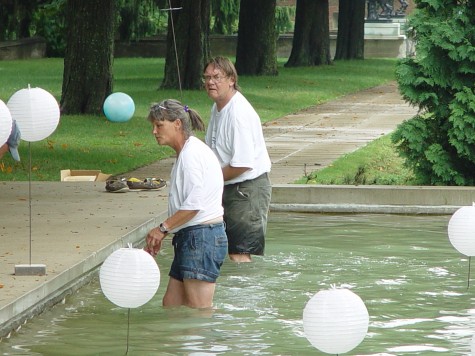 The big gesture? I had the idea to affix paper lanterns to slender steel rods anchored with bricks which would sit on the on the pool bottom. Advance measurements of the water depth enabled us to create the impression that the lanterns were floating on the surface of the water. What fun it was to get in these fountains; I never expected this opportunity to come along. A crew of four of us spent the better part of the afternoon wading in the water.
The big gesture? I had the idea to affix paper lanterns to slender steel rods anchored with bricks which would sit on the on the pool bottom. Advance measurements of the water depth enabled us to create the impression that the lanterns were floating on the surface of the water. What fun it was to get in these fountains; I never expected this opportunity to come along. A crew of four of us spent the better part of the afternoon wading in the water.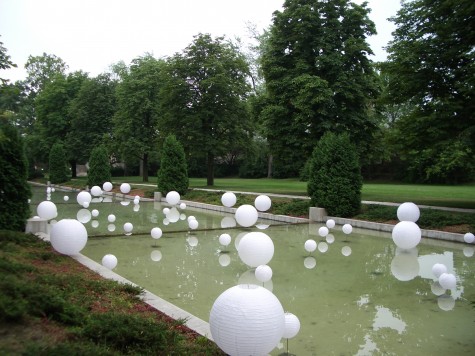 We set up hundred of lanterns of different diameters. Each steel rod had a platform at the top holding a votive candle. As we set the lanterns, we lit the votives rated to burn for ten hours, and hoped no more rain or wind would come our way. I was equally concerned that no water from the pools wick its way onto the paper. I was interested in creating a little moonlight magic, not a wet paper mess.
We set up hundred of lanterns of different diameters. Each steel rod had a platform at the top holding a votive candle. As we set the lanterns, we lit the votives rated to burn for ten hours, and hoped no more rain or wind would come our way. I was equally concerned that no water from the pools wick its way onto the paper. I was interested in creating a little moonlight magic, not a wet paper mess.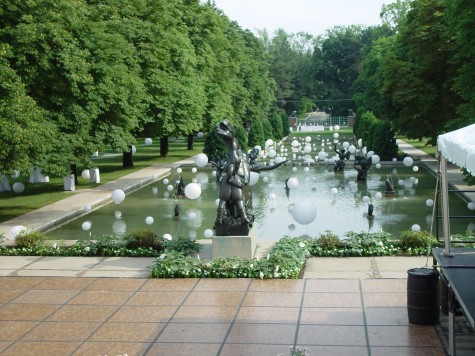 It seemed the rain had cleared off, and we did finish with an hour to spare before guests were due to arrive. The reception would begin at the very far end of the pools, and guests would wind their way uphill.
It seemed the rain had cleared off, and we did finish with an hour to spare before guests were due to arrive. The reception would begin at the very far end of the pools, and guests would wind their way uphill. 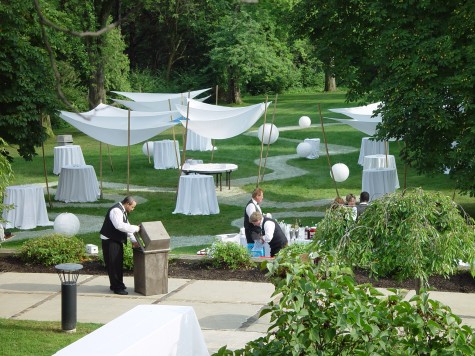 I was happy to have finished my part as the catering staff was setting up. I was on my way home to get dressed; I did not want to miss how all of this would look at night.
I was happy to have finished my part as the catering staff was setting up. I was on my way home to get dressed; I did not want to miss how all of this would look at night.  Attending an event gives you the chance to experience it as other people do. There is plenty to be learned from this-what proves awkward, what is not visually strong enough when a space is full of people, what proves to be good that you never gave a moment’s thought to. Any party in a garden will surprise you.
Attending an event gives you the chance to experience it as other people do. There is plenty to be learned from this-what proves awkward, what is not visually strong enough when a space is full of people, what proves to be good that you never gave a moment’s thought to. Any party in a garden will surprise you.
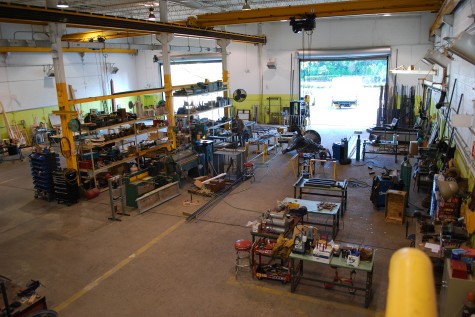
 The upper peninsula of Michigan, and the Sault in particular, is home to a substantial population of American bald eagles. They are proud of the fact that the eagle which symbolizes our entire nation thrives here, as well they should be. The bald eagle is as much a local treasure, as it is a national one. As any fountain placed on City property would be subject of discussion, design and review by committee, it seemed those firecely wild and independent birds would make a fitting subject for a sculpture, and appeal to a broad audience. We chose a subject matter we knew would strike a chord with a number of people. Given some drawings and dimensions of this object, a CAD drawing was produced enabling the project to be quoted. Nothing with cities proceeds quickly, but it does proceed; we were cleared to build.
The upper peninsula of Michigan, and the Sault in particular, is home to a substantial population of American bald eagles. They are proud of the fact that the eagle which symbolizes our entire nation thrives here, as well they should be. The bald eagle is as much a local treasure, as it is a national one. As any fountain placed on City property would be subject of discussion, design and review by committee, it seemed those firecely wild and independent birds would make a fitting subject for a sculpture, and appeal to a broad audience. We chose a subject matter we knew would strike a chord with a number of people. Given some drawings and dimensions of this object, a CAD drawing was produced enabling the project to be quoted. Nothing with cities proceeds quickly, but it does proceed; we were cleared to build.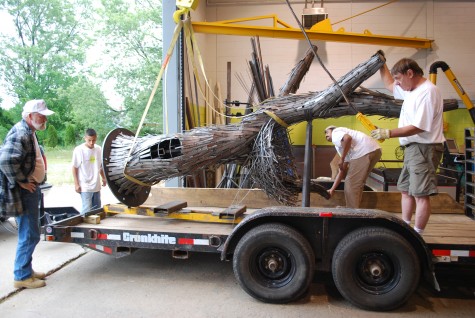 This fourteen foot tall steel sculpture interpretive of a tree would cover a plumbing system designed to propel water out the topmost branch. Attached to that tree would be a network of steel twigs representing an eagle aerie. The galvanizing tank in which we hot dip galvanize all of our steel is only 5.5 feet wide; one branch of the tree would have to be mechanically installed after the contruction process was complete. The fountain was designed in the round for viewing, not designed to fit a tank.
This fourteen foot tall steel sculpture interpretive of a tree would cover a plumbing system designed to propel water out the topmost branch. Attached to that tree would be a network of steel twigs representing an eagle aerie. The galvanizing tank in which we hot dip galvanize all of our steel is only 5.5 feet wide; one branch of the tree would have to be mechanically installed after the contruction process was complete. The fountain was designed in the round for viewing, not designed to fit a tank. 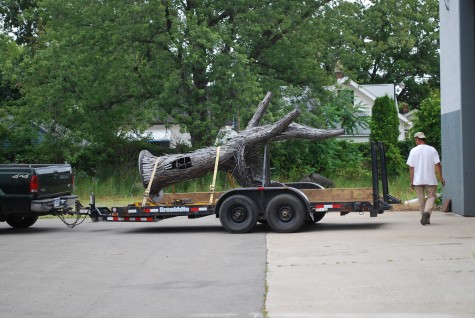

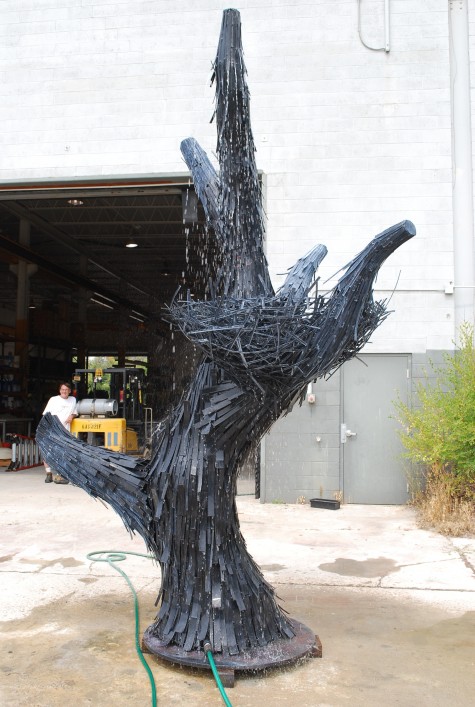
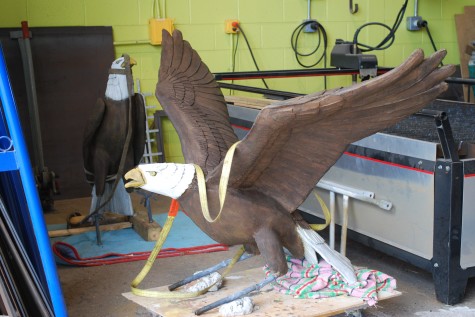 Life-size bald eagles hand sculpted from a steel rod and mesh galvanized armature, and acid stained mortar, would be attached to the sculpture via steel sleeves made to match the size and angle of the legs.
Life-size bald eagles hand sculpted from a steel rod and mesh galvanized armature, and acid stained mortar, would be attached to the sculpture via steel sleeves made to match the size and angle of the legs.  Buck followed this semitruck on whose whose flatbed that sculpture was securely tied down-for 340 miles. The next day, he supervised the installation, driving home late in the day. The sculpture had been installed.
Buck followed this semitruck on whose whose flatbed that sculpture was securely tied down-for 340 miles. The next day, he supervised the installation, driving home late in the day. The sculpture had been installed.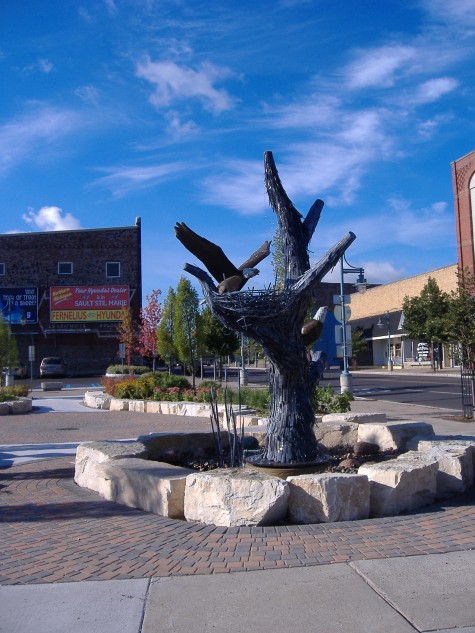
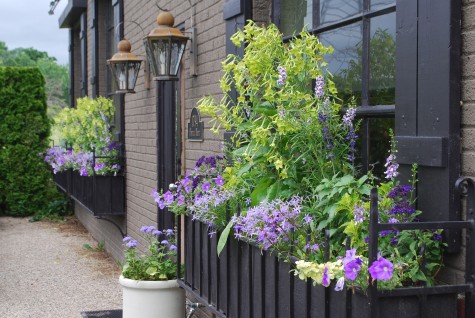
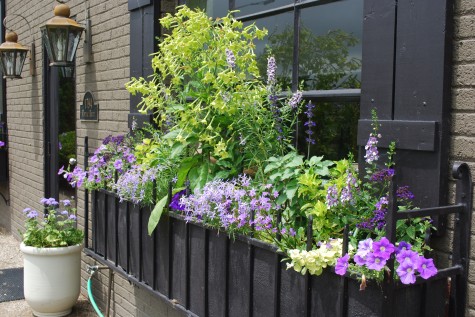 No matter what you fancy in your garden, nothing in it ever stands still. A garden actively grows, or actively sulks, or goes down. Some days I wish I could shift into neutral and coast, but I know better. I also know that as much as I would want to devote a chunk of time to nurturing all my plants, every day, that rarely happens. I have a demanding work life; moving that along every day takes priority. I hedge my bets some with plants that seem to handle the hit and miss nature of my care. Petunias thrive on this treatment; this is one plant that the more I fuss with them, the more they resent it. A trim once in a while is enough. Angelonia does not like cold weather, but it’s not a prima donna either. Once the hot weather comes, they come on strong.
No matter what you fancy in your garden, nothing in it ever stands still. A garden actively grows, or actively sulks, or goes down. Some days I wish I could shift into neutral and coast, but I know better. I also know that as much as I would want to devote a chunk of time to nurturing all my plants, every day, that rarely happens. I have a demanding work life; moving that along every day takes priority. I hedge my bets some with plants that seem to handle the hit and miss nature of my care. Petunias thrive on this treatment; this is one plant that the more I fuss with them, the more they resent it. A trim once in a while is enough. Angelonia does not like cold weather, but it’s not a prima donna either. Once the hot weather comes, they come on strong. 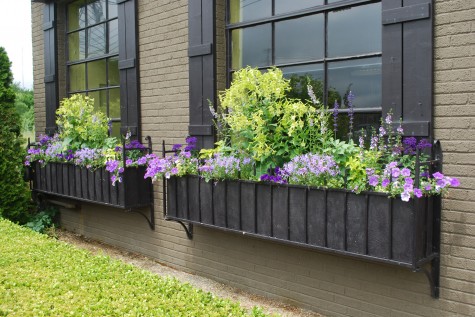 Blue salvia is puny early on; it is a late season annual. In a good year, they handle cooling fall temperatures with aplomb. I knew I would have these late. Planting the blue star-flowered laurentia was risky. Not only am I not so familiar with its habit, it has that look of an early season annual destined to peter out. This I cannot really explain, except to say some plants just look like they won’t do. The heliotrope was stuck in first gear; this plant likes hot weather. But for the moment, the lime nicotiana alata has my attention; the weather was instrumental in making it look perfectly happy. Every year, the weather is perfect for something; I thus follow the National Weather Service three month predictions with a lot of interest in late winter. Occasionally that helps.
Blue salvia is puny early on; it is a late season annual. In a good year, they handle cooling fall temperatures with aplomb. I knew I would have these late. Planting the blue star-flowered laurentia was risky. Not only am I not so familiar with its habit, it has that look of an early season annual destined to peter out. This I cannot really explain, except to say some plants just look like they won’t do. The heliotrope was stuck in first gear; this plant likes hot weather. But for the moment, the lime nicotiana alata has my attention; the weather was instrumental in making it look perfectly happy. Every year, the weather is perfect for something; I thus follow the National Weather Service three month predictions with a lot of interest in late winter. Occasionally that helps. 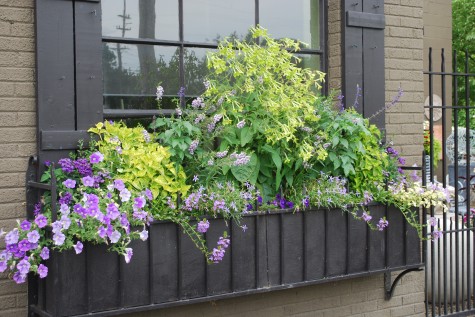 By August first, we were getting an 80 degree day once in a while. You can see the effect on the licorice and heliotrope; too little heat, too late. The flowering on the laurentia is slowing down, as I thought it would. Though the flowering is so- so, the plants are growing fine. The overall shape and the interaction of the group is the success of the box. Cool and dry made for unusually few bugs and no disease .
By August first, we were getting an 80 degree day once in a while. You can see the effect on the licorice and heliotrope; too little heat, too late. The flowering on the laurentia is slowing down, as I thought it would. Though the flowering is so- so, the plants are growing fine. The overall shape and the interaction of the group is the success of the box. Cool and dry made for unusually few bugs and no disease . By early September, my balanced box has gone too tall-bad maintenance on my part. Trimming plants back keeps them stocky, and encourages them to reflower. However, this height is a great look from the street; the flowers are visible over the boxwood.
By early September, my balanced box has gone too tall-bad maintenance on my part. Trimming plants back keeps them stocky, and encourages them to reflower. However, this height is a great look from the street; the flowers are visible over the boxwood.  As I predicted, the laurentia bloomed out, and needs replacing. By September 15, our weather is in transition. I expect night temperatures in the high forties this week yet. However, I am not willing to rip the boxes yet; I hold on to my summer season as long as I can. We are having our warmest daytime temperatures of the season. As there are plenty of plants that thrive in cool night temperatures, I will replace as needed.
As I predicted, the laurentia bloomed out, and needs replacing. By September 15, our weather is in transition. I expect night temperatures in the high forties this week yet. However, I am not willing to rip the boxes yet; I hold on to my summer season as long as I can. We are having our warmest daytime temperatures of the season. As there are plenty of plants that thrive in cool night temperatures, I will replace as needed. 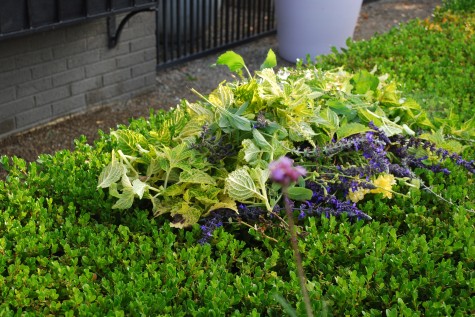 A good haircut and deadheading came first; late is better than never. As long as the warm weather holds, the coleus will respond quickly to the trim. There is no reason to give up what you have looked after all season. There is every good reason to keep what is good, and replace what isn’t.
A good haircut and deadheading came first; late is better than never. As long as the warm weather holds, the coleus will respond quickly to the trim. There is no reason to give up what you have looked after all season. There is every good reason to keep what is good, and replace what isn’t.